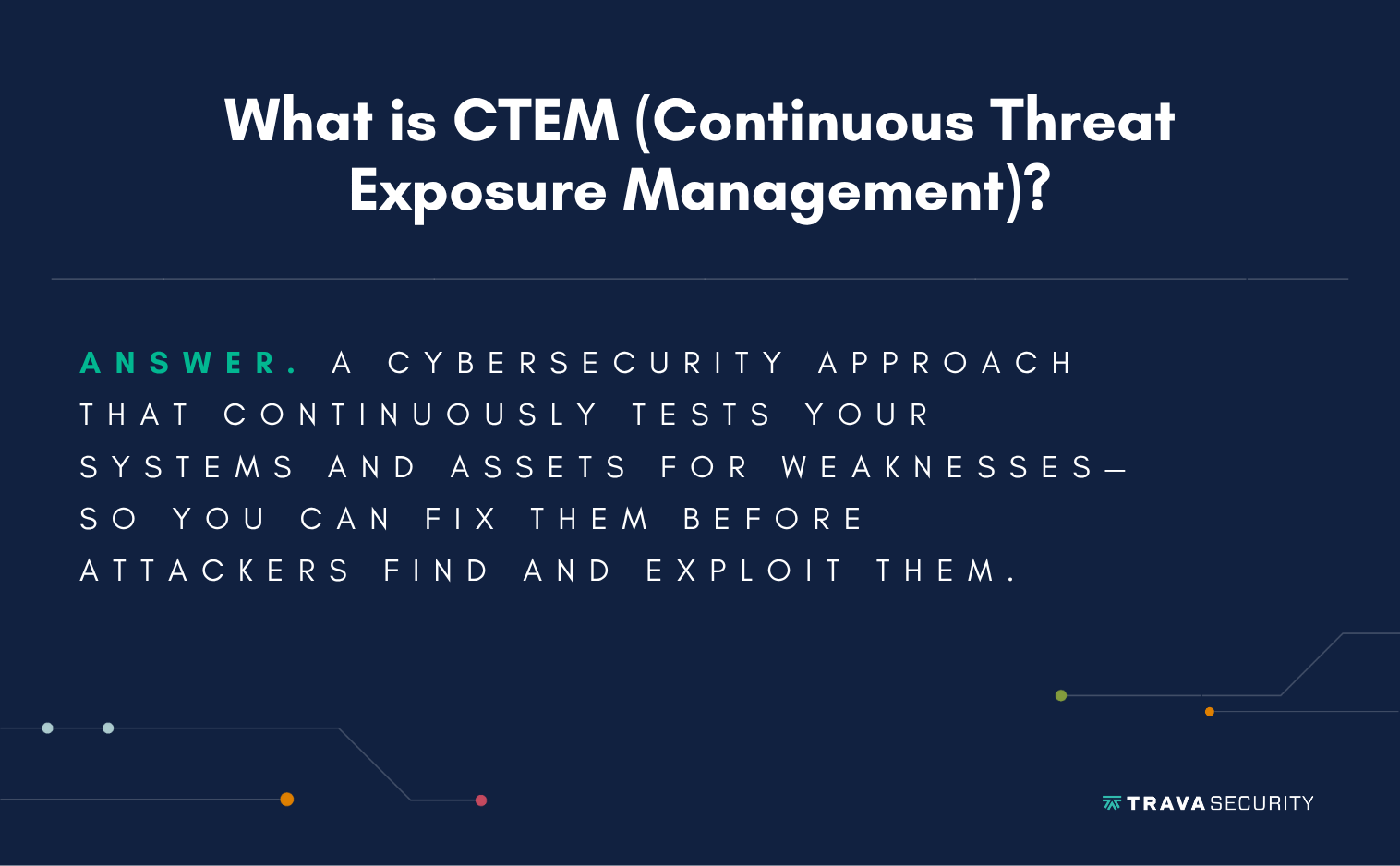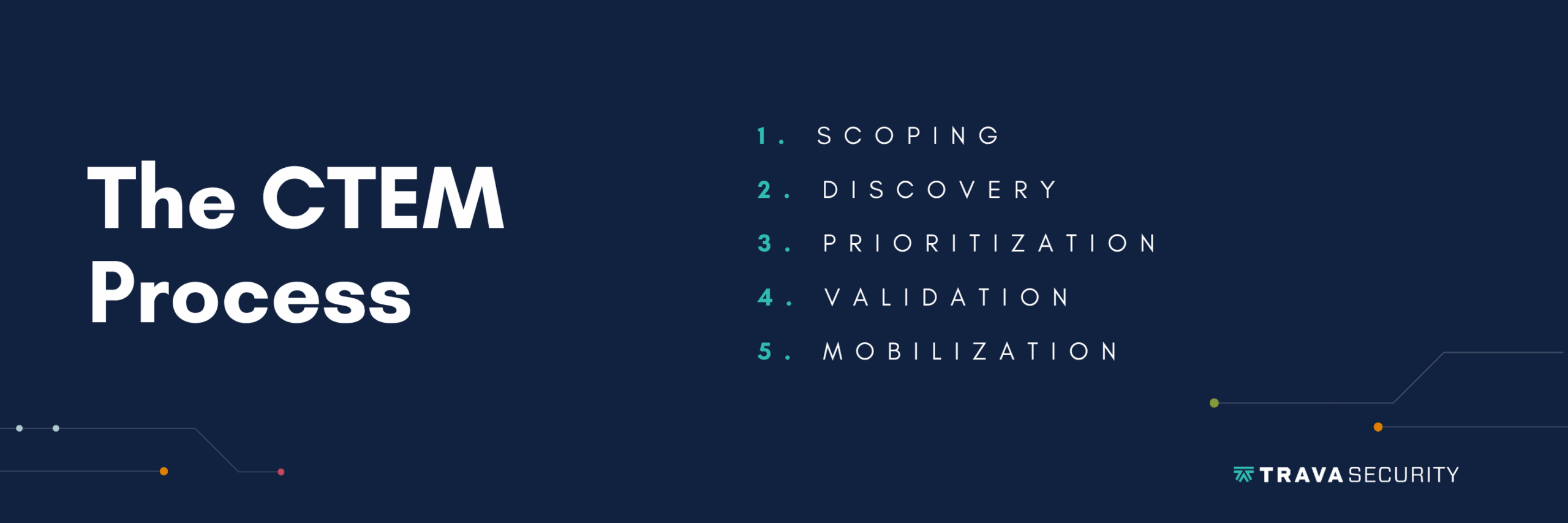Last updated: Septemeber 19, 2025
If you’re waiting until a cyber threat hits your business to do something about it, you may already be too late. For growing SaaS companies, even a single security incident can cause lasting damage to your brand, hurting your reputation and discouraging future clients from partnering with you.
That’s why designing a proactive cybersecurity roadmap is so important. It can help you identify and deal with threats before they stall operations and impact your bottom line. But how do you do it? One critical step is setting up a continuous threat exposure management system (CTEM). It’s a proactive approach to cybersecurity that can help you find and respond to breaches sooner and reduce risk.
This guide covers everything you need to know to get started, with an overview of the CTEM framework, practical solutions for implementation, and more tips for keeping your business secure.
What Is Continuous Threat Exposure Management (CTEM)?
CTEM is a cybersecurity strategy that emphasizes continuous monitoring. The idea is to continuously test your digital environment for weaknesses so that you can fix them before they cause a breach. This keeps you one step ahead of bad actors and reduces your likelihood of experiencing a serious security incident.
For the best results, you’ll need a system that monitors every avenue a hacker may try to exploit. This includes:
- People: Monitoring employees’ digital trails to watch for missing security controls, weak passwords, and unusual activity that could signify a breach.
- Devices: Placing controls on which devices can access your secure systems and monitoring logs for unusual activity.
- Processes: Monitoring your company’s digital processes and systems for vulnerabilities that a hacker may try to exploit.
- Tools: Evaluating the security strengths and weaknesses of key business tools and monitoring usage to catch the earliest signs of a potential breach.

Understanding the CTEM Process
Because it monitors many aspects of your digital infrastructure, implementing CTEM can be a detailed process. This typically includes:
- Scoping: Evaluating your digital infrastructure to see which assets should be monitored. CTEM generally focuses on processes, people, and systems connected to your most valuable business data.
- Discovery: Identifying vulnerabilities and exposures within your most important systems.
- Prioritization: Prioritizing threats based on their potential business impact. For example, your CTEM system may allocate more resources to protect client data if a breach would be disastrous to your reputation.
- Validation: Confirming whether the threats identified are real and potentially exploitable.
- Mobilization: Taking steps to reduce and remove risks as they’re found.
This process will take some time, especially if you lack internal cybersecurity expertise. That’s why many companies end up partnering with third-party cybersecurity experts like Trava. We can help you speed up the process and get the CTEM controls you need in place sooner.

Why CTEM Cybersecurity Matters
Maybe you’re already familiar with the most common cybersecurity threats and have controls in place to deal with them. If so, do you still need to invest in CTEM? The answer is generally yes. Here’s a closer look at why that’s true.
Why CTEM Is Essential
First, as the cost of cybersecurity incidents continues to climb, compliance standards are getting more robust. Many frameworks now require continuous monitoring. So, if you don’t have a CTEM system in place, you could struggle to get certifications like ISO 27001 and SOC 2. This could make it harder to find new clients.
Second, modern cyberattacks can derail a business. A single breach can destroy client trust, ruin your brand’s reputation, and put your company’s future at risk. This has made the cost of CTEM systems more justifiable. It makes sense to spend more on a defense system that’s always on when the potential costs of not doing so are higher than ever.
How CTEM Improves Cybersecurity
CTEM systems can improve your overall cybersecurity posture in the following ways:
- Risk-based spending: CTEM systems help teams discover their most significant risks and allocate limited security resources accordingly. This can maximize the level of protection you get from your budget.
- Shorter exposure windows: You’ll find and fix threats faster with a CTEM system in place. This reduces the amount of time that hackers have to find and target the same vulnerabilities.
- Integrated threat validation: CTEM systems help teams test the real-world impact of potential security issues before attackers do. It’s another example of how they keep you ahead of the bad guys.
- Ongoing visibility: With a CTEM system in place, you always know where you stand on cybersecurity. This ongoing visibility can help you make more informed, confident business decisions.
One way to think about the value these solutions offer is by comparing them to a traditional security risk assessment. Instead of testing for vulnerabilities once, CTEM systems are always looking for them. This provides ongoing protection instead of a snapshot of your threat levels at a single point in time.
What CTEM Solutions Deliver
Continuous monitoring systems support a wide variety of cybersecurity goals. They can replace many of the processes and tools you use today with a single, cohesive system for managing threats. For example, your CTEM solution can replace tools you’re currently using for:
- Real-time monitoring and alerting
- Penetration testing
- Vulnerability management
- Threat modeling
- Cybersecurity reporting and security roadmaps
Consider these factors when deciding whether to invest in a new CTEM solution. If you’re paying for a variety of cybersecurity tools, you may be able to cancel those subscriptions and replace them with a more cost-effective, unified tool.
How Trava Supports CTEM Principles
If you’re ready to adopt a CTEM framework, Trava can help. We offer compliance as a service solutions that cover everything you need to get ready for certifications like SOC 2 and ISO 27001.
We also offer a variety of stand-alone services that can help you make the transition to CTEM security. These include vulnerability and risk assessments, penetration testing, and advisory services, among others.
Who Needs CTEM?
You don’t have to be a large enterprise to benefit from CTEM. Researchers say 46% of all cyber breaches impact businesses with under 1,000 employees. So, even if you’re a small company, now could be the right time to invest.
If any of these scenarios sound familiar, CTEM could be right for your business:
- You don’t have a full-time security team, or you only have a few people trying to manage everything.
- You’ve completed a security audit or risk assessment and aren’t sure what to do next.
- You’re scaling quickly and worried your security posture isn’t keeping pace.
- You rely heavily on cloud tools and integrations, and haven’t checked these for security vulnerabilities.
CTEM as a Service: What You Should Know
CTEM solutions can be one of the most effective ways to fix a failing cybersecurity program. But not all are created equal. Some will be a better fit than others for your brand, your budget, and your goals. Here’s what you need to know to make a decision.
What Is CTEM as a Service?
Continuous threat exposure management as a service is an all-in-one solution designed to cover every aspect of your continuous monitoring system. Think of it as outsourcing the whole process to another company that specializes in it. There are pros and cons to that.
On the positive side, you’ll get the ongoing protection you need with minimal internal effort. The company you hire will monitor your threats, alert you when something requires your attention, and address incidents as they arise. You’ll have more time to focus on what you do best.
However, outsourcing your CTEM will be an ongoing expense that may not fit your budget. It could make more sense to hire a company that helps you design and install a system that you can manage on your own. Ultimately, you’ll want to compare several solutions to find the best value for your goals.
Benefits of CTEM as a Service
If you decide to outsource to continuous threat exposure management vendors, you can look forward to the following benefits:
- Access to expert security advisers without having to pay to add one to your team full time
- Automated validation and reporting
- Faster implementation of security fixes and improvements
- Help with evolving regulations and threats
- The ability to easily scale your system as business needs change
Take the First Step Toward Continuous Threat Exposure Management
Monitoring cybersecurity threats proactively is an essential part of protecting your company’s interests. But there’s more than one way to do it. If you have internal cybersecurity expertise, you can set up your own CTEM system to monitor and respond to threats in real time.
If you lack internal expertise, consider outsourcing. You can pay a company to run your CTEM system or outsource specific parts of that process, like penetration testing. Either way, Trava can help you move forward with personalized compliance services built around your needs.
So, whether you’re trying to earn a cybersecurity certification like ISO 27001 or just hoping to upgrade your security posture, contacting us is your next step. Book an intro call today to learn more about how we can help.


